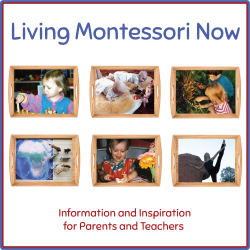Young children love to learn more about their bodies. The brain is so important that it's a great theme when adapted for the child's age and ability level.
This unit will be for preschoolers through first graders, although older kids could love some of the activities as well! At Living Montessori Now, I have a list of free brain printables. The free printables include my latest subscriber freebie (a Montessori-inspired brain pack). Here, I'm sharing ideas for using free brain printables to create Montessori-inspired activities for preschoolers through first graders.
You'll find many activities for preschoolers through first graders throughout the year along with presentation ideas in my previous posts at PreK + K Sharing. You'll also find ideas for using free printables to create activity trays here: How to Use Printables to Create Montessori-Inspired Activities. At Living Montessori Now, I have a post with resource links of Free Printables for Montessori Homeschools and Preschools.
Disclosure: This post contains affiliate links (at no cost to you).
Montessori Shelves with Brain-Themed Activities

These themed shelves have human brain-themed activities. (On another shelf, I'll have a few growth mindset activities throughout the month.) You’ll also find Montessori-inspired brain numbers, letters, and and more (part of my subscriber freebie pack, so just sign up for my email to get the link and password … or check the bottom of your latest newsletter if you’re already a subscriber)
I always have related books available throughout a unit. I have How Does Your Brain Work?, Think, Think, Think, and Young Genius Brains in addition to lots of growth mindset books. (I'll publish a post about those at Bits of Positivity.)
The open book on the shelf is the DK Smithsonian Picturepedia, which I love to have for a variety of themes. (It's actually for ages 8-12, but it has great pictures and lots of information that can be shared and adapted according to the interest and age of the child.)
In addition to the brain model, I have the Hape Your Body 5-Layer Wooden Puzzle Girl on the shelf. (There’s also a boy puzzle.) This is to give a general overview of the human body and show the brain with the other organs of the body.It was interesting that a week before we started this unit, Zoey asked me to get out this specific puzzle because she loved it so much when we used it for a mini skeleton unit last fall.
You could mix your brain-themed activities among your shelves according to curriculum area. Or you could have a special brain-themed area something like the one pictured. My shelves this month have a mixture of skill levels, although most are for older preschoolers and kindergartners. Many of the activities can be adapted for a variety of levels. If you’re a homeschooler, just choose the activities that work for your child’s interests and ability levels. If you don’t have room for all the activities you’d like to do, simply rotate them.
Human Brain Model with How Does Your Brain Work? Book
 How Does Your Brain Work? has an amazing amount of information for such a simple book!
How Does Your Brain Work? has an amazing amount of information for such a simple book!
I got the Learning Resources Brain Model for this unit. It seemed to be the best inexpensive brain model. It is small, but I don't have a large amount of shelf space. So the size is perfect for us. Of course, the directions for assembling it could be much better. My son-in-law put it together with my 4½-year-old granddaughter, Zoey. Zoey loves the brain model and really liked that her Uncle Tom showed her where the different brain parts were inside her own head.
"Brain" Spelled with Movable Alphabet Letters and Brain Page for My Body Systems Book
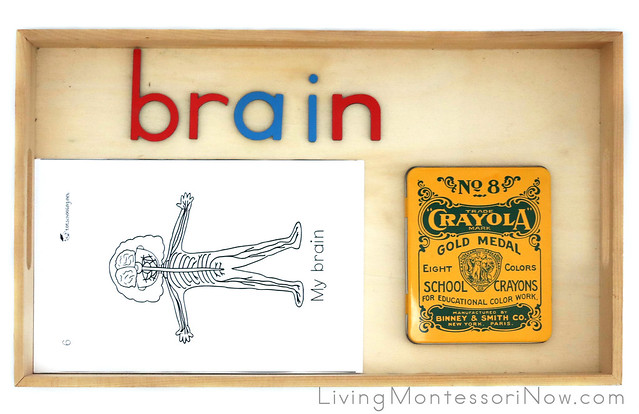 Free Printable: My Body Systems Science Booklet from Totschooling
Free Printable: My Body Systems Science Booklet from Totschooling Zoey and I often analyze words, so I spelled the word "brain" with the small wooden movable alphabet letters on the tray with the brain page for My Body Systems booklet. Zoey and I will be adding the other pages to the book, too. We'll read a bit about each body system during this unit.
Brain Addition with Miniature Brains and Bead Bars
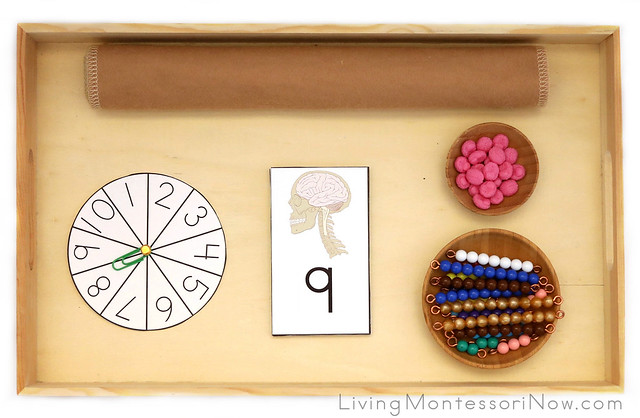 Free Printables: 1-10 Spinner plus Skull and Brain Numbers (part of my subscriber freebie pack, so just sign up for my email to get the link and password … or check the bottom of your latest newsletter if you’re already a subscriber)
Free Printables: 1-10 Spinner plus Skull and Brain Numbers (part of my subscriber freebie pack, so just sign up for my email to get the link and password … or check the bottom of your latest newsletter if you’re already a subscriber) This activity uses a piece of felt for a table mat (I used the Montessori Services felt table mat) and bead bars from the decanomial box in a Multicraft tray and a Bambu condiment cup (what I used here) or Montessori Services basket. (My bead bars, which I love, are from Alison’s Montessori. You can get bead bars on Amazon, although I haven’t personally used materials from those companies.)
Zoey is totally in love with the miniature brains from the Bag O' Brains (There are 25 brains in the bag, but I used 20 for this activity).
Zoey had so much fun with this addition activity! She used the spinner to choose the numbers, counted out the brains, found the matching number cards, and then placed the correct bead bars at the end. She did the activity a number of times. For a younger child, you could use the number cards for DIY cards and counters or another type of counting activity.
B Is for Brain Sand Writing Tray with Left and Right Brain Writing Cards
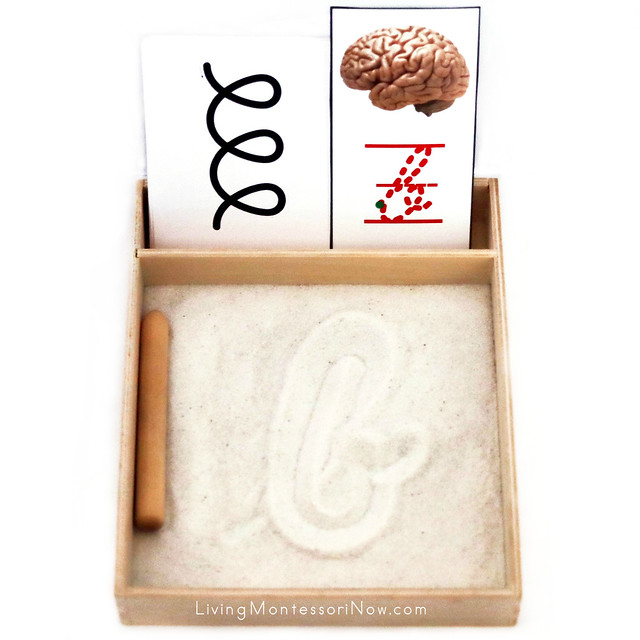 Free Printable: Montessori Sand Tray Writing for Left and Right Brain from Jana (This is a cool printable and very useful for a variety of ages.)
Free Printable: Montessori Sand Tray Writing for Left and Right Brain from Jana (This is a cool printable and very useful for a variety of ages.) Free Printables: Cursive "b" brain card for constellation writing tray (part of my subscriber freebie pack, so just sign up for my email to get the link and password … or check the bottom of your latest newsletter if you’re already a subscriber)
For the sand tray, I used the wooden tray from the Melissa & Doug Lace and Trace Shapes. You can use whatever tray or container work best for you, though. I had gotten some lovely white sand (for making kinetic sand and other projects), which works perfectly for the sand tray.
If you would like help with introducing phonetic sounds, introducing objects with sounds, or beginning phonics in general, check out my DIY Beginning Montessori Phonics with Preschoolers.
Brain Movable Alphabet
Free Printables: Brain Movable Alphabet (part of my subscriber freebie pack, so just sign up for my email to get the link and password … or check the bottom of your latest newsletter if you’re already a subscriber)The brain letters can be used to match to sandpaper letters or movable alphabet letters and place letters in alphabetical order. You can also use them for traditional movable alphabet word-building work.
Brain ai Phonogram Card and Booklet
 Free Printables: “ai” brain font card (part of my subscriber freebie pack, so just sign up for my email to get the link and password … or check the bottom of your latest newsletter if you’re already a subscriber)
Free Printables: “ai” brain font card (part of my subscriber freebie pack, so just sign up for my email to get the link and password … or check the bottom of your latest newsletter if you’re already a subscriber) Free Printable: Green Series ai Letters from MontessoriSoul (Print two sets if you want to use the pictures for movable alphabet word building.)
This is so easy to prepare, yet it isolates the ai phonogram very well.
I have a post and video on how to introduce words starting with phonograms, even with very young children.
Tray with Parts of the Brain Puzzle and Identification

Free Printables: Brain Puzzle and Brain Center Learning Materials form The Crafty Classroom This was amazingly easy to prepare, yet is colorful and appealing to young children. You could have a control page for the puzzle, but I placed it on the tray so that the printed page could be the control even though it's too small for the child to build the puzzle right on it.
For a younger child, I would have a printed control page the same size as the actual puzzle. I just printed the puzzle on cardstock, although you could always trace around the parts on felt to make a felt puzzle if you prefer.
I printed out the page that's shown in quarter size and made a small control chart for the labeling activity.
Brain Functions Activity
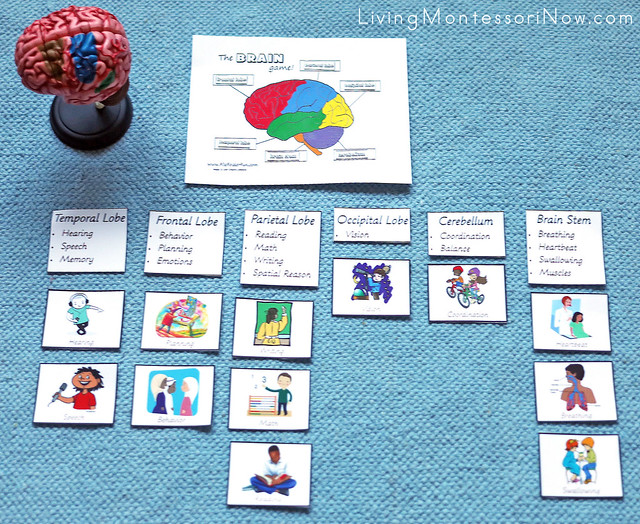
Free Printable: Brain Functions Cards from Noor Janan Homeschool
These couldn't be easier to prepare. I simply printed and cut them out and then placed them in a Montessori Services basket.
This is a simple way to reinforce the functions of the parts of the brain.
Making a Brain Hemisphere Hat (shown in lower right of the bottom shelf)
Free Printable: Brain Hemisphere Hat from Ellen Mchenry's Basement Workshop (This was designed for ages 10-14, but it can be adapted for a variety of ages.)I have this on the shelf, but I'll be doing a number of other brain activities first. This will help consolidate the knowledge from our unit.
More Free Brain and Anatomy Printables
Go to my post at Living Montessori Now for links to free brain and growth mindset printables from around the blogosphere: Free Brain and Growth Mindset Printables and Montessori-Inspired Brain Activities. And be sure to subscribe to my email list if you'd like to get an exclusive free printable each month (plus two more awesome freebies right away): Free Printables.Growth Mindset Resources
I have lots of growth mindset resources at Bits of Positivity. I'll be adding more each week during this unit study, too.More Anatomy Activities and Resources
- Montessori-Inspired Heart and Circulatory System Activities
- Montessori-Inspired Skeleton Activities
- “All About Me” Free Printables and Activities for Back to School
- Handwashing Activities for Kids – Free Songs and Lessons
- Free Skeleton Printables and Montessori-Inspired Skeleton Activities
- Hands-on Fun with Montessori-Inspired Human Skeleton Activities
- Human Body Unit Study Pinterest Board

Deb Chitwood is a certified Montessori teacher with a master’s degree in Early Childhood Studies from Sheffield Hallam University in Sheffield, England. Deb taught in Montessori schools in Iowa and Arizona before becoming owner/director/teacher of her own Montessori school in South Dakota. Later, she homeschooled her two children through high school. Deb is now a Montessori writer who lives in San Diego with her husband of 43 years (and lives in the city where her kids, kids-in-law, and grandkids live). She blogs at Living Montessori Now.
